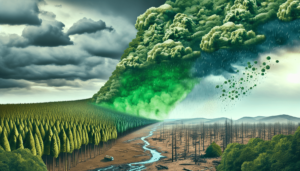How Does Climate Change Affect the Ocean: Introduction
When we think about the ocean, we often conjure up images of the infinite blue horizon, captivating marine life, or perhaps just the soothing rhythm of waves breaking against the shore. It’s a vast, awe-inspiring body of water that covers about 70% of our Earth. The ocean is a generous provider, offering us not just a substantial amount of our food, but also the very air we breathe. Yet, for all its timeless wonder, the ocean is far from immune to change. So, how does climate change affect the ocean?
Human activities, particularly those leading to climate change, are dramatically altering the ocean’s chemistry and temperature. From the deepest abyss to the sparkling surface, nothing in the ocean remains untouched by the grip of climate change. As global temperatures continue to rise, our oceans absorb much of the heat and carbon dioxide, setting off a cascade of effects that have far-reaching implications for both marine and human life. But how exactly does this happen, and what are the potential consequences? Let’s dive in and explore.
The Warming Waves: More Than Just a Day at the Beach
Climate change and its effects on the ocean are, in many ways, a bit like a well-crafted mystery novel – full of unexpected plot twists, ominous turns, and a sense of urgency. And the first chapter of this novel? It’s about warming waters.
You see, when we talk about global warming, we often picture melting icebergs or sweltering heat waves. But the reality is, more than 90% of the heat trapped by greenhouse gases is actually absorbed by the ocean. So when we say ‘global warming’, it’s really more about ‘ocean warming’. Sure, warmer waters might sound fantastic for a leisurely swim, but when it comes to the overall health of the ocean, it’s not quite so sunny.
Coral Reefs: The Underwater Cities in Peril
Imagine a bustling underwater city, home to thousands of species, where every creature plays a crucial role in a vibrant ecosystem. These are coral reefs – nature’s magnificent metropolises beneath the waves. However, the warming ocean is causing these cities to fall silent. How, you ask?
When waters get too warm, corals undergo a process called coral bleaching. They expel the colorful, life-sustaining algae living in their tissues, turning completely white. It’s like a city suddenly losing its electricity, plunging into a ghostly silence. If the water doesn’t cool down soon enough for the algae to return, the coral can die. With coral reefs providing habitats for many marine species, their loss could lead to a domino effect on ocean biodiversity.
Marine Life: More Than Just Finding Nemo
Fish and other marine creatures are particularly sensitive to changes in their environment. As ocean waters warm, it’s like their world is constantly shifting and transforming, and not for the better.
Changes in water temperature can mess with the timing of fish migrations and reproduction, leading to mismatches between species and their food sources. Additionally, warmer waters can push species to migrate toward colder regions, upsetting the delicate balance of marine ecosystems.
From the smallest plankton to the largest whale, no marine creature is immune to the impacts of warming waters. It’s like the ocean’s version of musical chairs, where the rules keep changing, and the stakes are sky-high.
Ocean Acidification: The Oceans’ Heartburn
While warming waters grab much of the spotlight when we talk about climate change impacts on the ocean, there’s another insidious issue lurking beneath the surface: ocean acidification.
Now, you may be thinking, “Ocean acidification? Is that like giving the ocean a massive case of heartburn?” Well, in a way, it is. Here’s why:
The ocean acts as a natural sponge, absorbing about a quarter of the carbon dioxide emitted by human activities. Normally, this would be a good thing – less carbon dioxide in the atmosphere means less global warming. But as the old saying goes, too much of a good thing can be bad.
As the ocean absorbs more and more carbon dioxide, it’s undergoing a process known as acidification. It’s a bit like downing a fizzy soda. The carbon dioxide reacts with seawater to form carbonic acid, which increases the water’s acidity. So essentially, our ocean is on a carbonated diet, and the result is a global case of aquatic heartburn.
The Impact on Shellfish
For creatures such as shellfish, ocean acidification is particularly bad news. Shellfish, including oysters, clams, and tiny sea snails, depend on the calcium carbonate in the water to build their shells. However, as the ocean becomes more acidic, it becomes harder for these creatures to form their shells, and existing shells can even start to dissolve.
Imagine trying to build a sandcastle while the tide is coming in. No matter how fast you pile up the sand, the waves keep washing it away. That’s the uphill battle shellfish are facing in an increasingly acidic ocean. It’s like being slowly dissolved in a bath of fizzy soda – definitely not a pleasant thought!
The impacts of ocean acidification don’t stop there. Many of these shellfish form the base of the ocean food web, and their decline could have profound effects on larger marine creatures, including many species of fish that we humans depend on for food. So, the ocean’s heartburn could eventually become our own headache.
Shocking Effects of a Warming Ocean: Sights to Sea
Ocean warming is stirring up some shocking phenomena. As our marine world grapples with the heat, the effects ripple through the ecosystem, creating alarming changes that are not only bizarre but potentially catastrophic.
Extreme Weather Events: More than a Storm in a Teacup
The ocean plays a crucial role in regulating our planet’s climate. By absorbing heat, it helps to buffer the impacts of global warming. However, as the ocean continues to heat up, it’s creating some dramatic weather effects.
Think of the ocean as a massive, heat-powered engine driving our planet’s weather systems. When the engine overheats, it can start to sputter and spark, causing unexpected and extreme weather patterns.
These include more frequent and powerful hurricanes, typhoons, and cyclones. Warmer ocean temperatures can supercharge these storms, leading to greater wind speeds and increased rainfall. It’s like the ocean is brewing a tempest in a teapot, only the teapot is planet-sized, and we’re all along for the ride!
Sea Level Rise: It’s Not Just Melting Ice
Sea-level rise is another significant impact of ocean warming. As water heats up, it expands. This process, known as thermal expansion, is causing sea levels to rise. It might sound like a drop in the bucket, but remember, we’re talking about a bucket that covers 70% of Earth’s surface.
Thermal expansion, coupled with melting ice caps and glaciers, is causing sea levels to rise at an alarming rate. Low-lying islands and coastal cities are at increasing risk of flooding, and some could even disappear beneath the waves. It’s like our planet is slowly but surely getting a massive, unwanted water feature.
Ocean Deoxygenation: The Seas Are Out of Breath
As the ocean warms, it’s also losing its ability to hold onto oxygen. Warmer water holds less dissolved oxygen than cooler water. This effect, known as ocean deoxygenation, is essentially creating vast ‘dead zones’ where marine life cannot survive.
Moreover, warmer surface waters make it harder for oxygen-rich surface waters to mix with deeper, oxygen-poor waters. So the life-giving oxygen that many marine creatures depend on is becoming scarcer, especially in the deep sea.
Imagine trying to breathe at the top of a tall mountain, where the air is thin and oxygen is scarce. Now imagine that mountain is underwater, and you’re a fish trying to survive. That’s the struggle many marine species are facing in a warming, deoxygenating ocean.
The Rising Tide: More Than Just Dampened Spirits
Sea level rise is more than just a few extra inches of water at the beach. It’s a creeping, unstoppable force that’s gradually reshaping our coastlines and threatening to engulf low-lying regions. The causes are primarily twofold: melting glaciers and ice sheets, and thermal expansion due to warming ocean waters.
Coastal Flooding: From Beachfront to Waterworld
As sea levels rise, coastal areas around the globe are experiencing increased flooding. It’s not just a matter of soggy beach towels. Inundation can cause extensive property damage, loss of life, and displacement of people.
Imagine waking up one day to find that your beachfront property has become a beach-under property. Not exactly the sort of swimming pool you had in mind, right?
Loss of Coastal Habitats: More than a Change of Scenery
Rising sea levels also have significant impacts on coastal ecosystems. As saltwater moves inland, it can drown plants in coastal marshes and forests, leading to habitat loss for many species. Picture your favorite camping spot, now underwater. Not quite as charming when the picnic tables are submerged and the resident wildlife has moved out, is it?
Impacts on Human Health: A Rising Tide of Concern
Increased flooding and erosion from rising sea levels can also have direct impacts on human health. Contaminated floodwaters can spread diseases, while saltwater intrusion into freshwater supplies can lead to water shortages and poor water quality. Imagine turning on the tap only to find that your once fresh drinking water now has a salty tang. Not quite as refreshing, is it?
Economic Consequences: Drowning in Costs
The economic impacts of sea level rise can be staggering. Damage to properties and infrastructure, loss of land, increased insurance costs, and spending on adaptive measures can run into the billions. It’s like we’re all trying to stay afloat in a sea of mounting expenses.
In a nutshell, the rising tide is more than just a damper on our spirits. It’s a global issue that’s reshaping our world in profound and potentially devastating ways.
Our Health at Stake: More than Sunburns and Jellyfish Stings
Believe it or not, climate change’s impact on oceans can also affect our health. From increased risks of water-borne diseases to potential threats to our food sources, it’s not just about sunburns and jellyfish stings anymore.
Toxic Algal Blooms: The Green Menace
Ever heard of red tides or toxic algal blooms? As ocean waters warm, we might see more of these harmful blooms that can poison marine life and even the air we breathe. Talk about a sea-rious problem!
Seafood Safety: A Fishy Business
We all love a good seafood platter, but with warming oceans, our favorite delicacies could turn dangerous. Warming waters can lead to an increase in bacteria and toxins in seafood. It’s like playing Russian Roulette with your shrimp cocktail!
How Does Climate Change Affect the Ocean: Conclusion
After delving into the intricate web of how climate change affects the ocean, it’s clear that this phenomenon is far-reaching and multi-faceted. It’s not just about warmer waters; it’s a complex ripple effect that touches every corner of marine life and coastal communities. From intensified hurricanes to health risks, economic repercussions, and coastal erosion, the consequences of climate change in the ocean are interconnected.
However, the same interconnectedness applies to our efforts to combat climate change. Every action we take, no matter how small, sets off ripples that can eventually create waves of change. By understanding how climate change affects the ocean, we can make more informed choices and contribute to a healthier planet. So, let’s take what we’ve learned in this article and go out there to make waves of positive change.
How Does Climate Change Affect the Ocean: FAQs
Can warmer oceans lead to more hurricanes?
Absolutely. Warmer ocean waters act as a primary energy source for hurricanes. When sea surface temperatures rise, more heat and moisture are transferred to the atmosphere, creating conditions conducive to storm formation and intensification. This phenomenon leads to more intense and potentially more frequent hurricanes.
For instance, the Atlantic Ocean has seen an increase in the number of major hurricanes in recent years, partly attributed to warmer waters. Hurricanes like Harvey in 2017 and Maria in 2017 demonstrated the devastating impacts of these more intense storms, causing extensive damage and loss of life.
How does sea-level rise impact coastal communities?
Sea-level rise is a grave concern for coastal communities worldwide. As global temperatures rise, polar ice caps and glaciers melt, and ocean waters expand due to thermal expansion, sea levels are steadily increasing. This upward trend leads to coastal flooding and erosion, threatening homes, businesses, and entire communities.
Coastal flooding can inundate low-lying areas, causing damage to infrastructure, displacing residents, and posing substantial economic costs for affected regions. For instance, cities like Miami, Florida, experience frequent “sunny-day flooding” during high tides, which disrupts daily life and poses long-term challenges to urban planning and resilience.
What is the economic impact of changes in the ocean due to climate change?
The economic ramifications of ocean changes due to climate change are extensive. Fishing industries are adversely affected by shifting fish populations and declining catches due to altered ocean conditions. Tourism, particularly coastal and marine tourism, can suffer as coral reefs degrade, reducing the allure of popular destinations. Shipping routes may need to be reconfigured as changing ocean conditions, such as altered currents or sea ice retreats, impact transportation efficiency and safety. Moreover, the economic ripples extend beyond these industries, affecting local and global economies. For instance, the loss of coral reefs worldwide could lead to economic losses in the billions of dollars annually.
How does climate change affect our health via the ocean?
Climate change poses health risks via the ocean in several ways. Warmer ocean waters can lead to an increased prevalence of water-borne diseases, such as Vibrio infections, which thrive in higher temperatures. Rising sea temperatures can also alter the distribution and behavior of marine species, potentially leading to the expansion of harmful algal blooms and the release of toxins into the food web, affecting seafood safety.
Additionally, the ocean’s role in modulating climate patterns can indirectly influence human health through impacts like extreme weather events and changes in the distribution of disease vectors like mosquitoes. For example, the spread of diseases like dengue and malaria can be influenced by shifts in climate patterns associated with oceanic changes.
What can governments do to mitigate the effects of climate change on the ocean?
Governments hold a crucial role in mitigating climate change’s effects on the ocean. They can implement policies to reduce greenhouse gas emissions, such as regulations on fossil fuel consumption and incentives for renewable energy adoption. Investment in research and monitoring efforts is essential to better understand oceanic changes and their impacts.
Additionally, governments can foster international cooperation through agreements like the Paris Agreement to collectively address climate change’s global nature. At the local level, governments can implement coastal management strategies, enforce regulations to protect marine ecosystems, and develop adaptive measures to prepare for rising sea levels and more frequent extreme weather events. Mitigating climate change’s effects on the ocean necessitates a multifaceted approach, combining global and local actions to protect these invaluable ecosystems.




